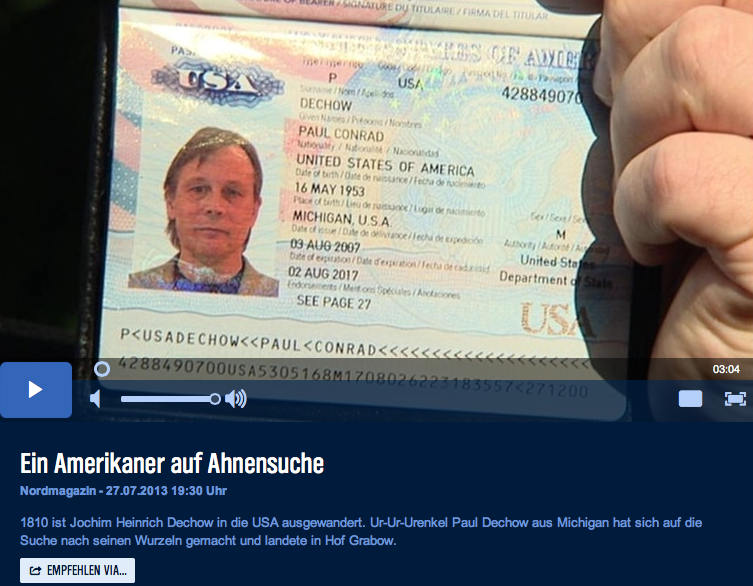No place like home

How this faculty member’s search for his family lineage landed him on German TV.
It is summertime in Mecklenburg, Germany. Grain swathes the fields of farming towns Kladrum and Hof Grabow. In the center of the agricultural environs are the homes — their centuries-old stones and mortar still solid. The air is hot, and chickens and other livestock strut through residents’ front yards in search of shade.
Dr. Paul Dechow is “home.”
What began in childhood as a quest to learn more about his family roots has taken Dechow, chair of biomedical sciences, to his ancestral roots in eastern Germany. This summer, it also made him the subject of a broadcast on German news network Norddeutscher Rundfunk.

For years Karl-Heinz Steinbruch, former archivist in Schwerin, Mecklenburg’s capitol, has worked as a freelance archivist and historian, conducting genealogical searches for clients all over the globe. It is not uncommon for some clientele to meet him face to face at the end of a long search, where he’ll show them the landscape, churches, cities and villages of their ancestors.
“But Paul is a special guy,” says Steinbruch. “Paul was the first American who could find his ancestors in the first census of Mecklenburg in 1819.”
It’s a rarity, since illiteracy was common in those days, and family dates of significance often faded with the years. But Dechow — applying a career’s worth of research experience — was able to locate an ancestor born in 1810, which Steinbruch cross-checked with Kladrum parish records.
In combination with emigration and baptism records dating back to 1677, the two were able to uncover Dechow’s oldest known-ancestor: Christoffer Dechow.
When broadcast network NDR approached Steinbruch about running a story on an American returning to northern Germany to find his roots, he knew just the person to ask.
Dechow — who visited his family’s ancestral home in July — was happy to oblige. The reporters filmed the men nearly half the day, as Dechow, his own camera draped over his neck, ambled along dirt roads and meandered into historic churches.
“It’s such a powerful feeling to go back and walk where your ancestors have walked, and to see how they lived,” says Dechow. “In a way it feels like going home again — a home you didn’t know you had but is still there. You feel a kinship with the place.”
Dechow got to that moment by approaching his genealogy research in a manner not too distant from his studies in the lab.
“Any research takes a trained skepticism along with an attention to detail, and I think those are the similarities,” says Dechow. “A lot of my research is on evolution. I’m interested in the history of humanity, and this is just my little piece of it and how it fits back into the bigger picture.”
By early August, in the cool of the Michigan summer, he stood over a table at the Port Oneida Fair filled with photos and posters detailing the Dechow family history. It’s something he does each year when he returns to the Dechow ancestral farm, which is part of the Port Oneida Rural Historic District in the Sleeping Bear Dunes National Lakeshore by Lake Michigan. This year, relatives, residents and tourists had a few more photos to study. Despite the fact that the images were captured halfway across the world in a country many of them have never visited, the homes inhabited by the first Dechows don’t look all that different from the family’s Midwestern farmscapes.
The photos help answer questions Steinbruch describes as logical: “Who are my ancestors? How and where were they living? And why did they emigrate?
“Paul gave an answer to these questions in the interview. His last words were, ‘I came back home.’”
—Jenny Fuentes